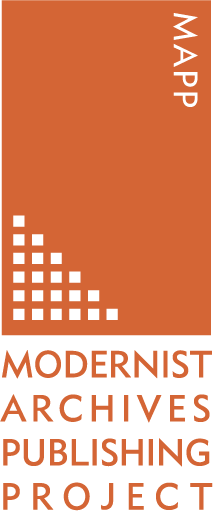This post will provide a few excerpts from the chapter "Building a Critical Digital Archive" from our collectively-authored book Scholarly Adventures in the Digital Humanities. This post is intended as a introduction to understanding the distinctions among different objects found on this site. For the full description and rationale, please refer to our book.
With MAPP, we wanted to construct our digital archive—an aggregation of the digitized materials held by numerous library-based archives—so that we could answer questions pertinent to our scholarship while also transforming the materials into a network of relationships that future scholars might use. This goal meant that we needed to consider the standards for information organization and access. Rather than an archive in the strictest definition of the word, what we sought to build was a collection of related materials from geographically disparate archives so that our team’s desired scholarly narratives can come more easily to the fore. Another goal of ours was to provide access to digital transcriptions of the texts. We have only just begun this phase of the process (as the preparation of digital scholarly editions of even a single, short text is a laborious and time-consuming effort), but we knew from the outset that we needed a way to embed these texts within the larger network of materials, people, and presses we were gathering.
One of our animating questions has been: how can we represent the material circumstances that have shaped modernist literary production and publishing in a digital form? How can we avoid providing just another content management system that divorces item from context? Clearly, a digital collection can never substitute for direct engagement with the print materials, but it can foreground the physical through metadata and newly digitized images of the material conditions.
How can we represent the material circumstances that have shaped modernist literary production and publishing in a digital form? How can we avoid providing just another content management system that divorces each piece of content from the whole? How can our platform respect and present our scholarly understanding of the importance of bibliographic codes and publishing history to the meaning of a literary work? Our data model, pictured below, is part of how we attempt to answer this questions.

Our model begins with an assumption that a ‘book’ is not a single object, but is the product of a network of people, businesses, material artifacts, and words. Unlike a library catalog, where all the editions of a work are typically listed under the same heading, we needed to connect multiple editions and physical copies of a work, but to do so in a way that distinguishes among them. Our data model thus separates a book into three parts: a Work, an Edition, and a Primary Object. ‘Work’ is equivalent to what literary critics often call a ‘text,’ the words alone of the canonical printed edition divorced from the social, economic, or material contexts. In making these distinctions, we have closely followed the Functional Requirements of Bibliographic Records (FRBR) metadata standard, albeit with slightly different terminology that is more familiar to book historians. We added two more types of records: ‘Related Materials’ and ‘Correspondence’ to describe other materials from the publishers’ archives.



